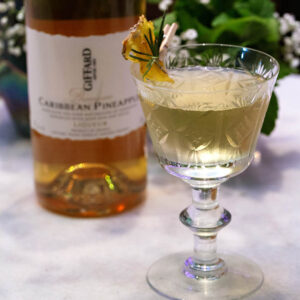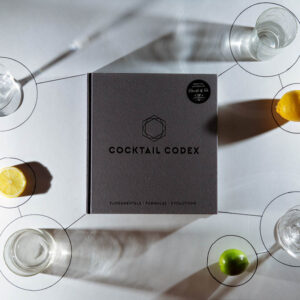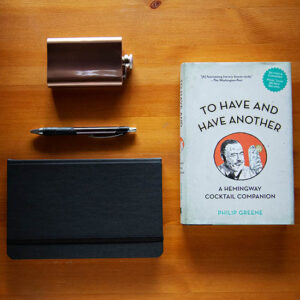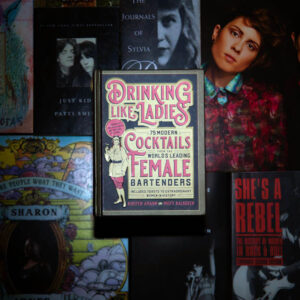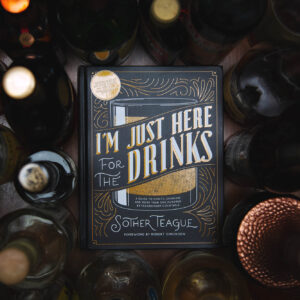It’s Boozy Bookshelf time! Our monthly feature where our friends Marlene and Lucas of Famous Last Words Bar in Toronto review books of a boozy nature. This month, they hit up The Dead Rabbit Grocery & Grog Drinks Manual by Sean Muldoon, Jack McGarry and Ben Schaffer. Here is both of their opinions of said book.
.jpg)
Marlene’s Review:
Released, as it was, on the heels of (all previously reviewed here) Death & Co’s book, The Bar Book, and Liquid Intelligence, I can only imagine that the authors and publishers of The Dead Rabbit book must have been looking to carve out their own niche in the pantheon of bar books. So this is, quite unabashedly, a cocktail recipe book. Yes, it begins with the engaging story of how the Dead Rabbit came to be (and to be named the best bar in the world), but the focus here is on drink specs.
Impractical as a home bartender’s guide, given the completely lack of focus on technique and the myriad ingredients required for almost every execution, it does provide solid inspiration for anyone who longs to experiment and has a fairly deep back bar at their disposal. I’d argue that it’s also not ideal for Canadian bartenders either, dominated as it is by recipes which call for numerous and often complex ingredients that not only are not available in Canada but are virtually unknown to all but a few, so without a fair bit of experience behind the bar it can be a little tricky to figure out workable substitutions. (That said, where there’s a will there’s a way, and their Bantam punch (which calls for Arrack) has become a go-to at famous last words, with Cachaca standing in for the funkier Dutch East Indian spirit.)
All this to say that the Dead Rabbit Drinks Manual is a book by cocktail nerds, for cocktail nerds. Every drink has an origin story, many if not most recipes have sub recipes and the assumption going in is that you either already have more than a passing knowledge of how to build a drink – or that you’re content to leave the drink building to someone who does. I mean sure there’s a recipe for sherbet…but you need to already know that we’re not talking about the frozen confection. All told, I counted recipes for no fewer than 10 infusions, 15 syrups and 13 tinctures, so this is not a book you want to whip out if company’s coming in 10 minutes and you need a simple but impressive cocktail.
What keeps this from being completely impenetrable to the novice – at least in my mind – is the stunning photography (never made a Suissesse or an Excellent Negus? You’ll want to at least try after seeing how beautiful they look) and the writing style itself. While the chapters are divided into categories as varied as Punches; Cups and Cobblers; Flips, Possets and Nogs; etc., the introductions are humorous, tongue-in-cheek and offer a hope that maybe there’s some fun to be had among all this very serious drinking. What would we expect from two Irishmen, after all? (Though one suspects that writer Ben Schaffer probably deserves the credit for many of these bon mots and clever turns of phrase.)
One thing that does drive me slightly mad about this book is the lack of consistency in how the recipes are presented: some start with the least voluminous ingredient and build up, while others do the opposite. Still others seems to start somewhere in the middle. In the “Cocktails” chapter two recipes on facing pages for old-fashioned variants perfectly illustrate this seemingly random nature of spec treatment: the first lists the 2oz of Irish whiskey first while the second puts its 2 oz of Rye sixth on the list.
Muldoon and McGarry are clearly cocktail historians and the origins and inspirations for the drinks are on full display. They’ve taken obscure drinks from the 19th and early 20th century and modernized them with a breathtaking range of spirits and brands. Their affection for the pioneers is also evidenced by the adoption of a vaguely French naming convention (as in Julep a la Thomas and Whiskey Smash a la Terrington). I guess it’s one way of paying homage, but it does make for a mouthful at times (Claret Cup a la Fouquet, anyone?).
Marlene’s Last Word: This is definitely not a beginner’s guide to cocktails. It is, however, an entertaining – and visually stunning – book. If you want a healthy dose of history along with some advanced cocktail recipes and some inspiration for bold ways to combine flavours, you could do much, much worse. It also looks pretty good on a coffee table.
Lucas’s Review:
Of the books we have reviewed so far, 2015’s “The Dead Rabbit Drinks Manual: Secret Recipes and Barroom Tales from Two Belfast Boys Who Conquered the Cocktail World” resembles a conventional cocktail manual or cookbook the most. This is particularly odd when you consider how innovative their cocktail menus can be; rather than releasing an impressive coffee table artifact like Death & Co’s book, the Dead Rabbit Drinks Manual might as well be a Gordon Ramsay recipe book. Not to impinge on the quality of the book itself — with lovely photographs, a clear and concise structure, and curated index it’s functional as all get out — or on Gordon Ramsay’s books, of which I own a couple, the Dead Rabbit book is almost rather plain following 2014’s offerings. Published by Houghton Mifflin, a big-time house, it screams professionalism but is less innovative than expected. This may be why they’re putting out a different volume, with a graphic novel format, later this year. (Watch this space for a review after release!)
As mentioned, this isn’t meant to be a slight on the book itself. While the book’s exterior design and physical layout are somewhat conventional, the unique color palette can make it stand out, and the art design, if a little busy and baroque, is quite appropriate for the bar and attractive.
As for content of the book itself, it hearkens back to the time of cocktail manuals rather than cocktail instruction, resembling the Savoy or PDT, but with a couple of nice twists. I’m actually quite fond of the lack of a lengthy “here’s what agave is, yet again” chapter detailing spirits, and the opening chapter, detailing the Mr. Muldoon and Mr. McGarry’s road to the bar and winning the Spirited Award’s “Best New Bar” category is entertaining, if a bit congratulatory. I am *extremely* fond of how the book teaches history (and drink structure!) via its own structure: by separating chapters into different kinds of punches, flips, sours, fixes, smashes, juleps, and other classic drink families rather than by spirit, it teaches bartenders and cocktail enthusiasts to make drinks not by spirits family, but by drink style. It also allows them to throw in a few entertaining history lessons in the chapter headers rather than hiding drink history in its own chapter, doomed to be ignored.
As a punch enthusiast, I’m particularly fond of the focus on punches, though I do have to question their use of lime as the example for oleo-saccrum. (Other citrus makes killer oleo easily and without needing to resort to a microplane. Lime, with its thin skin and less oil, makes for a much less rich oleo — if you are set on lime, I suggest blitzing the zest combo’ed with sugar in a food processor and then filtering after making into a syrup.) The focus on flips, smashes, and cobblers is great, as it helped me (and many others, I’m sure) see interesting ways to use these classic drink styles that were ignored for much of the latter 20th century. Again, I must emphasize how lovely some of the photography is — surpassed only by Meehan’s recent book amongst the books we have reviewed thus far.
Lucas’ last word: “The Dead Rabbit Drinks Manual” is only what its title implies — a list of drinks recipes. It can be a worthy addition to a large cocktail-book collection, a useful brainstorming tool for an experienced bartender, or a lovely gift for a Dead Rabbit enthusiast, but it isn’t very functional beyond the recipes themselves. Despite my preference for their style of drinks over, say, Death & Co’s, and despite prefering how they list drinks by style (c’mon — Regan started sort of doing this 15 years ago and most classic books do things this way rather than by spirit, everyone should be doing things this way), it requires pre-existing knowledge of how to make drinks and potentially a cognitive leap to add the information within to your repetoire. Because of that, I can’t recommend The Dead Rabbit’s book as a drink-maker’s first — or even fifth — book, and would suggest checking it out from a library before buying it yourself. There’s great stuff in there, and well presented, but unless you really want a list of flips and punches on hand (like I often do), it might not be worth your tip money.









